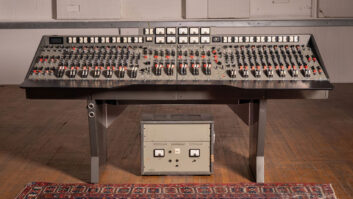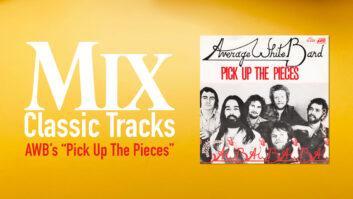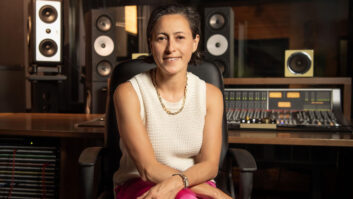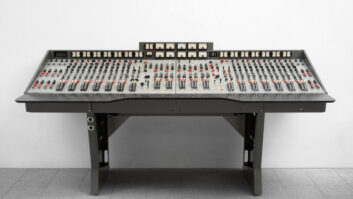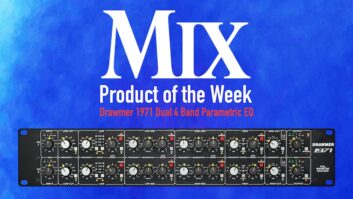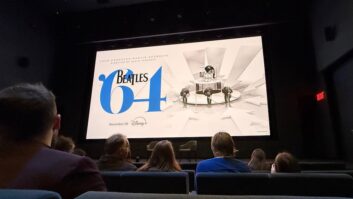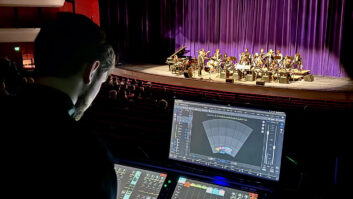March 26, 1999, marked the thirtieth anniversary of the first concert by the legendary Allman Brothers Band. The date fell, fittingly enough, during what has become a tradition for the group throughout the past decade-an extended run of performances at New York’s historic Beacon Theater.
The Allman Brothers Band is steeped in both musical and even visual tradition-their show includes a re-creation of the famous light shows of the ’60s, courtesy of the Brotherhood of Light-and the band has earned a reputation for putting on long and varied shows that draw from their roots in Southern blues, rock and jazzy improvisation. During 30 years of playing both together and apart, the Allmans’ live setup has grown and changed along with the industry, evolving from primitive beginnings with a Sunn Coliseum P.A. to the unique stage and monitoring system they employ today.
A FIVE-WAY SYSTEM IS HARD TO FINDFront-of-house engineer Bud Snyder has been with the band since their rejuvenation in 1989 and has mixed every one of their shows at the Beacon. Snyder has continually honed the band’s P.A. setup, which is supplied by db Sound of Des Plaines, Ill. “It’s strange that I’m using one of the oldest P.A.s in the world,” says Snyder in reference to the mid-’80s system design. “It’s just that it’s a really good P.A.-a five-way system, which is really hard to find nowadays. It fits what we do, because we are a ’60s/’70s rock band that’s moved into the ’90s. We are using a lot of new stuff, but the basic sound of the Allman Brothers hasn’t changed. It still is Marshall amps and the Hammond B-3. We’ve done some changes in the past ten years; digital crossovers came out, so we’ve been able to time-align the delay in the crossovers and we sometimes even do offsets between the 18s [in the P.A.] and the bass rig onstage. We couldn’t do that ten years ago.”
Designed by db Sound’s Harry Witz, the Allmans’ sound system is made up of db Sound HD series components loaded with JBL drivers and Electro-Voice Manifold Technology system models, all driven by Crest 8001 and Crown PSA-2 amplifiers. At the Beacon Theater, the nine cabinets comprising each of the L/R side stacks included two EV MTL-4s, one HD-B, four HD-4s and two HD-3s. (The HD-B is a folded bass, horn-loaded with four 15-inch woofers; the HD-4 is a full-range four-way cabinet containing four 15s, one 12, a 2-inch horn and “bullet” tweeters; the HD-3 is a three-way cabinet featuring two 12s, two 2-inch horns and four bullets.) Additionally, across the front of the stage are four EV DML 1152s, each containing two 15s and a 2-inch horn. “We went in the first year with just the nine boxes a side,” says Snyder. “There were problems downstairs because of the volume that the band plays onstage. I’ve had people in the first ten rows-and they’re right in front of the Marshall rigs-come back during the intermission and say, ‘I’m not really hearing the vocals or the B-3 the way I’d like to hear them, and I’m right up front, shouldn’t I be able to hear them?’ We added the DMLs the following year to try and supplement. The four mono cabinets across the front are fed off a matrix into which I feed vocals, keyboards and drums, no guitars.” A center cluster of six DMLs was added during the second year to aim more top end at the top audience rows.
Walking through the entire venue, it becomes obvious that the best seats in the house are not in those coveted first ten rows. Snyder agrees: “I think the mid-balcony [about 20 rows back and 20 feet above the floor] is probably the prime listening spot. You get a more honest mix of the building.”
For his FOH console, Snyder selected a Gamble EX56. “Prior to selecting this system I’d been out touring with the Gregg Allman Band and the Dickey Betts Band,” he explains. “I had a lot of opportunity to try out different consoles, pretty much anything and everything that existed. I chose the Gamble EX56 basically because of its preamps. It’s the best-sounding board, especially for this band, that you could possibly have.”
TRUE TO THEIR ROOTSAlthough the band avails itself of audio advancements of the past three decades, they remain true to their roots, even down to employing roadies Joe Dan Petty and “Red Dog,” who have been with the band since the very beginning and are as well-known to hard-core fans as the bandmembers are. Petty concentrates on Dickey Betts’ guitars and vintage Marshall amps; Red Dog handles the drums, a job that has expanded to include a three-man rhythm team of original drummers Jaimoe and Butch Trucks, plus percussionist Marc Quinones, who has been with the band since 1991. “When we first started out, we had two sets of drums, Jaimoe had his congas, and that’s all we had,” recalls Red Dog.
Today, the drum setup is the most complex aspect of the band’s stage show and requires nearly 30 microphones. “Jaimoe’s kit is a total traditional jazz set,” explains Snyder. “Small drums, heavy wood, no hole cut in the kick. The kick is miked from behind and is a snare mic as much as it’s a kick mic, and vice-versa with the snare. They both run through the compressors, but the threshold is set way up so they’re barely getting any compression. I use a Beyer M88 on the kick and a 57 on his snare. Then I use a Sennheiser 504; now it’s called a 604. It’s a cheap version of the 421, but because of its size and your ability to move it around the drum, I actually like it better than using the 421. The rack and floor toms are all 504s. The overheads are AKG 414s.
“Butch’s set is just a straight-ahead late-’60s/early-’70s rock drum kit-Shure SM91 on the kick, Beta 56 on the snare, 504s on the two racks, 504s on the two floors, two 414s on the overheads. For the timpani, I use an RE20 on the bottom end and two Shure SM81s Y-ed. Which takes us to percussion, Marc Quinones. We start with a timpani bottom mic which usually is a 421. The overhead on the right is an AKG 414. A Beta 57 is split between the two bongos. The two congas are Beta 57s. He has a cowbell that he plays with his foot and a cowbell that he plays with his hand. Those two are Y-ed and miked with 57s. Then we go to the toys [various percussion pieces]-the stage left overhead is the AKG 414. Then we move to his gong. The bottom input is an SM58. The top end of the gong is an SM81 condenser.”
The guitar amps of Betts and Jack Pearson [who has since been replaced by Butch Trucks’ nephew Derek Trucks] are miked using standard mic choices: an SM57 and a 421. Rather than EQ’ing the channels, Snyder gets the desired guitar tonality by blending the two mics. Acoustic guitars go into DIs. The bass guitar, played by the phenomenal newcomer Oteil Burbridge, goes through an SVT with two 15s and eight 10s using a combination of DI and a Beyer 88.
“I prefer a Shure Beta 57A for vocals,” Snyder continues. “I go straight through one of the channels, no EQ except for a little highpass to get rid of some of the bottom and give it a little separation in the mix. There are no limiters on any of the vocals.” Although an incredible singer like Gregg Allman needs no help to make his voice sound great, Snyder has a Drawmer 1960 stereo tube compressor strapped across the vocal sub group. “The thresholds actually run at about +5, +10,” he notes. “I very seldom touch the compression-maybe where five of them are singing. I just play right around the threshold so you hear the tube sound. If I pop the tube out you’ll hear immediately that it’s a much warmer sound. I’m not big on gates or compressors; I never have been.” Snyder also uses a Drawmer 1960 stereo tube compressor on the guitar subgroups and has a 2-channel Tube-Tech compressor inserted on the bass DI and mic inputs.
The Hammond B-3 Gregg Allman uses is of the same vintage as the Marshalls and is connected to a Leslie 142 speaker: “It’s miked in stereo,” notes Snyder. “Normally I use an RE20 on the bottom of the cabinet. Now I’m using a Shure B-52 that I’m trying out; I still haven’t made up my mind which I really like. Normally I use 57s on Leslie stage right and Leslie stage left to get the stereo image around the horns. The piano [an Ensoniq] is just a stereo DI left and right out.”
A STRAIGHT-AHEAD SOUNDWhen queried regarding the effects used for a band with such a straight-ahead sound, Snyder notes, “Reverbs are real simple with the Allman Brothers-they’re not into effects. I use reverbs more to blend the mix than anything. I’ve gone from all kinds of reverbs to really simplified right now. I’m using a Lexicon 300 for vocal sounds and guitars. I’m using a Lexicon PCM 80 on the drums and percussion and a little bit on the acoustics. I always use a Yamaha SPX on vocals and guitars. I use a pitch-change on the vocals and guitars. I pitch it up and down, both sides. I just use pitch and left and right delays about nine cents up, nine cents down. And then I put a little flange/phase as far as the delays between the two of them. And I also use an old slapback, the Roland 3000.
“Because I only have 56 inputs on the console, I have a 24-channel Mackie sidecar to run effects back through. All the reverbs come back through as a stereo patch to the main console and then I slap ’em back against the delay unit and then blend those.”
Monitor mixes are handled by Earl McCoy, who worked his second Beacon run with the Allmans this year. McCoy uses a Midas XL-3, which has been in the band’s setup for a few years. “The unique thing about this monitor system is that not all the mixing is done from this console. We have two submixes going onstage with the drummers,” explains McCoy. “Butch and Jaimoe both have their own little Mackie submixers so they can control things like guitar volume and vocal volumes right there. As far as monitors themselves go, they’re all EV FS212 boxes, which have two 12s and a 2-inch horn. They’re powered by Crown 36X12 Macrotech amplifiers with a pip card crossover set at about 1,250 Hz.”
In a world where most bands are running on MIDI and samples, it’s somewhat heartening to hear that McCoy’s main problems are somewhat old-fashioned. “The biggest part of mixing the Allman Brothers is cueing the vocals on time, because Jack and Dickey-mostly Dickey-play pretty loud out there. Most monitor engineers will leave the vocals on so they don’t have to worry about muting and un-muting, but Dickey plays at such a volume that the vocal mic actually picks up quite a bit of his guitar, so we had to go to muting the vocals until they’re being sung. They all come in at different times so you have to be pretty quick with your fingers on the mute buttons. I don’t use any gates at all-they don’t really like the sound of gates.”
As they enter their fourth decade together, the Allman Brothers have endured, prospered and crossed over generations to the point where a large percentage of their ardent fan base weren’t even conceived at the time their first album was. They are also, perhaps, the only band from their era still putting out new material that is readily accepted into their concert repertoire. The songs from their most recent studio efforts draw as much, if not more, applause than their time-honored hits, proving that, for the Allman Brothers Band, the road might indeed go on forever.
